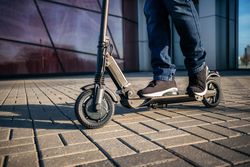
Over the last few years, a mobility revolution is present in the UK’s urban roads, pavements and cycle paths.
Micro-mobility vehicles, also called Personal e-Transporters (PeTs), have zipped up the popularity stakes for short city journeys. They're fast enough to beat driving in rush hour traffic or walking, yet small enough to tuck under your office desk during the day or in your hallway cupboard at night.
Many pedestrians and road users, however, are less enamoured by e-scooters, e-skateboards, hoverboards and their like, which have rolled into our cities so rapidly that the law has struggled to keep up.
What is their legal status, what are their safety implications, and could this be set to change in the near future?
Legal limbo: the roads
Unlike electric bicycles and mobility scooters for people with disabilities, there is no legal framework specifically for electric skateboards, scooters and Segways.[1]
There isn’t even a single agreed term for the category: both 'micro-mobility vehicles' and 'powered transporters' are in use.
Legally, they are currently categorized as 'motor vehicles', whose definition as set out in the Road Traffic Act 1988 is 'any mechanically propelled vehicle intended or adapted for use on roads'.
E-scooters and their like must therefore abide by regulations that have been drawn up with cars in mind, such as those concerning insurance, licensing and registration.
In practice, it is impossible for riders to fulfil such requirements for their powered transporters, meaning that these vehicles are effectively banned from the public roads.
Although this legal status emerged as default, it has recently been confirmed in the law courts.
In two separate cases, e-scooter riders lost their appeals against their convictions for driving without insurance on the public highway, with one also convicted of driving without a licence.[2]
Legal limbo: pavements and cycle paths
Micro-mobility vehicles are not permitted on cycle paths or cycle lanes, even though mobility scooters and many electric bicycles[3] are. Bridleways are also officially out of bounds.
As they are motorized, powered transporters are banned from pavements and footpaths, where their speed poses a danger to the safety of pedestrians.
Again, this ban was confirmed in the law courts, where a Segway rider recently lost his appeal against a conviction for riding on the pavement. [4]
Where can you ride an e-scooter?
Essentially, e-scooters can be ridden only on private land with the permission of the landowner. [5]
If you are a farmer, therefore, you can entertain yourself riding up and down your tracks on a Segway or electric skateboard. Otherwise, to be totally sure you’re not going to end up with a fine, points on your driving licence or even a criminal conviction, you’ll need to head to a dedicated Segway route, such as those found on Forestry Commission land.[6]
Scooter safety
If you’ve been in central London or any other major city recently, you might find it hard to believe that e-scooters and e-skateboards are officially banned.
Many people ride theirs on the roads and in cycle lanes, perhaps in the erroneous belief that the laws on electric bicycles apply. And as they are uninsured, drivers whose cars are damaged by e-scooters are unlikely to be recompensed.
Some riders zip down pavements in the knowledge that they’re hard to stop, making pedestrians fear for their safety.
As powered transporters are unregistered, police would struggle to track down offenders too.
Changes in the law
Signs are afoot, however, that this situation could be changing.
The sheer number of powered personal transporters in major urban areas is making legalization and regulation increasingly necessary.
Furthermore, as local authorities struggle to meet air quality targets, and as congestion rises in cities, many transport experts are thinking that 'small is beautiful'.
Transport for London (TfL) is leading the way, with TfL Director Mike Brown saying it is 'inevitable'[7] that e-scooters will one day become legal on the public roads.
Although there is a ban on riding scooters and hoverboards in TfL stations,[8] TfL’s Director of Innovation has called for a thorough safety review of the vehicles, with a view to establishing enforceable regulations, restrictions and speed limits.[9]
Department for Transport review
Those calls have been heard by the Department for Transport (DfT).
Its 'Future of Mobility: Urban Strategy', published in March 2019, outlines plans for a Regulatory Review, with micro-mobility vehicles as a focus.[10]
The strategy recognizes the 'blurring of previously long-established vehicle definitions' that their inception entails.
It states: 'It is essential that people have the chance to make the most of the opportunities from micro-mobility, in a way that is safe for both the users of these new vehicles and road users more generally.'
The review will explore testing regimes to ensure that micro-mobility vehicles are safe for use, and conduct local trials.
This could lead to new definitions of vehicles, finally ending the legal limbo.
All of which could result in micro-mobility scooters no longer being regarded as a nuisance or a legal anomaly, but as an essential plank in urban transport planning policy.
Services and technologies could be shaped to include them, and new traffic regulations and street designs could develop to accommodate them.
Conclusion
Notwithstanding the legal position in the UK, these 'vehicles' are used widely and legally in other countries. BSI is closely monitoring the work done in IEC on charging and safety of PeTs, in order to contribute in their adaptation.
It remains to be seen what will emerge from the DfT review and trials, or how this will be shaped through consultation.
It’s possible that the UK could follow Germany’s lead, where such vehicles are limited to 12 mph.[11]One thing seems certain: micro-mobility vehicles are here to stay.
[3] https://www.gov.uk/government/publications/electrically-assisted-pedal-cycles-eapcs
[4] http://www.bailii.org/cgi-bin/format.cgi?doc=/ew/cases/EWHC/Admin/2011/2032.html
[5] https://www.gov.uk/government/publications/powered-transporters/information-sheet-guidance-on-powered-transporters
[6] https://goape.co.uk/adventures/forest-segway?perpage=48&adventure=forest-segway&latitude=&longitude=
[7] https://www.standard.co.uk/news/transport/tfl-chief-mike-brown-calls-for-safety-review-as-he-predicts-electric-scooters-will-become-legal-on-a4184666.html
[8] http://content.tfl.gov.uk/tfl-conditions-of-carriage.pdf
[9] https://www.lbc.co.uk/news/tfl-quicker-government-electric-scooter-review/
[10]https://assets.publishing.service.gov.uk/government/uploads/system/uploads/attachment_data/file/786654/future-of-mobility-strategy.pdf
[11] https://www.lbc.co.uk/news/tfl-quicker-government-electric-scooter-review/


